Do you ever wonder if your WordPress site is actually reaching people? Without proper analytics, you’re basically running it blind. You won’t know which pages visitors enjoy most, how they found you, or what makes them leave without taking action.
That’s why every WordPress site needs Google Analytics (GA). It’s free and gives you the insights you need to understand your visitors and grow your site. Even today, it remains the best way to understand your audience and make smarter decisions.
At WPBeginner, we use MonsterInsights across all our websites because it simplifies complex Google Analytics data into easy-to-understand information. We’ve also looked at other solutions to see what works well for small businesses.
In this guide, we’ll show you three ways to easily set up Google Analytics on your WordPress site — even if you’ve never done anything technical before. 🧑💻
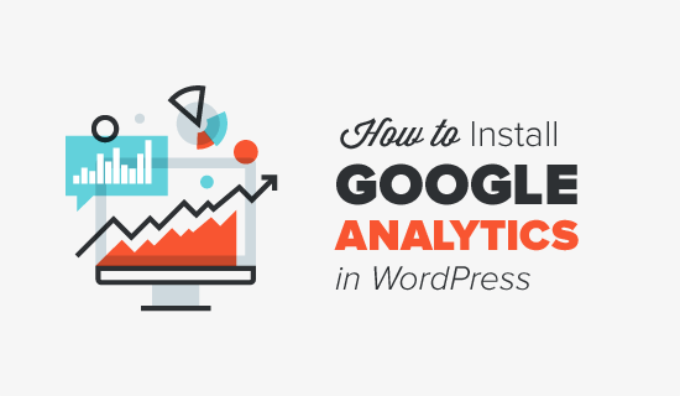
✏️ Quick Note: This is a comprehensive guide – here’s what we’ll cover to help you navigate:
- First, we will explain why Google Analytics is important, how it can help you grow your website, and how to sign up for a GA account if you haven’t already.
- Second, we will show you different methods to install it on your WordPress site. This article covers the MonsterInsights method, along with two alternative approaches.
- Finally, we will explain how to view your traffic reports in Google Analytics.
Why Is Google Analytics Important for Bloggers?
Once you start a blog, your #1 goal is to get more traffic and subscribers. Google Analytics helps you make data-driven decisions by showing you the stats that matter. You can see:
1. Who visits your website?
This part of analytics provides details on the geographical location of your audience, the browser used to visit your site, and other key information, including screen resolution, JavaScript support, Flash support, language, and more.
This data is extremely useful, and it can help in different ways. When creating a custom website design, you can use the user data to make sure that your site will be compatible with your audience.
For example, if you see that most of your visitors are using mobile devices, you can prioritize making your site’s mobile experience as smooth as possible.
2. What do people do when they are on your website?
You can track where the users are going on your website, how long they stay on your website, and the bounce rate (the percentage of users who exit your site on the first visit).
Using this information can decrease the bounce rate and increase your pageviews.
You can also find your most popular articles, articles that are not doing so well, and the kind of content your users are looking for.
3. When do people visit your website?
By looking at the hottest hours of the day for your site, you can pick the best time to publish your post.
If that time zone is not compatible with yours, then you can schedule your post for that hour.
4. How do people find your website?
This section of the analytics shows you where the users come from. For example, do they use search engines, enter direct links, or click on referral links from another site?
It also shows you what percentage of your visitors came from each of these sources. Google Analytics gives you a breakdown of each of these categories. If it is the search engine category, it shows which search engine generated the most traffic for you, such as Google, Yahoo, Bing, and so on.
The breakdown of referral sources shows you which sites you need to work with the most. If your top referral source is Facebook, you need exclusive Facebook content to make your audience feel special.
If your top referral source is an external website, then you might want to consider having a partnership with that website (guest post exchange or something else).
5. How do people interact with your content?
Google Analytics shows how your users interact with your site’s content. It shows you what percent of the users clicked on which link on your site and much more.
You can run A/B split tests by creating content experiments in Google Analytics to understand what works best to meet your goals.
By seeing user interactivity, you can work your content around your users. By seeing the answers to the questions above, you can focus on the strategies that work for your site and avoid methods that don’t work.
Simply put, eliminate the guesswork and focus on stats that matter so you can make data-driven decisions.
Don’t have a Google Analytics account? Just follow our quick step-by-step guide below:
How to Sign Up With Google Analytics
Google Analytics is available for free, and all you need is a Google or Gmail account to sign up. The signup process is quite simple. Just follow the step-by-step instructions below to create your Google Analytics account.
Step 1: Create a Google Analytics Account
First, you need to visit the Google Analytics website to sign up. When you are on the website, simply click the ‘Get started today’ button.
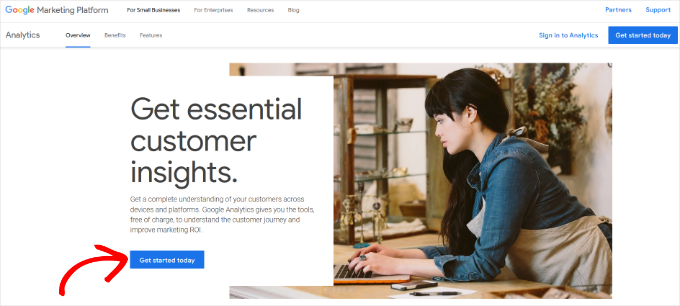
Next, you will be asked to log in with your Google account.
If you already have a Google or Gmail account, then you can use that to sign in. Otherwise, you can go ahead and create a Google account for yourself.
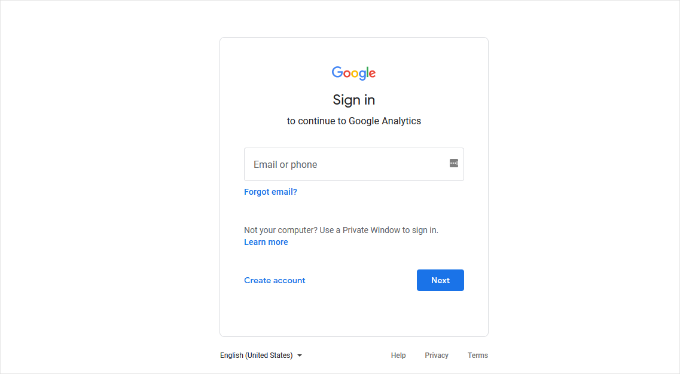
Step 2: Configure Your Google Analytics Account
Once you have signed in with your Gmail account, you will see a welcome screen like the one below.
This is where you will sign up for Google Analytics with your Gmail account. Go ahead and click the ‘Start measuring’ button.
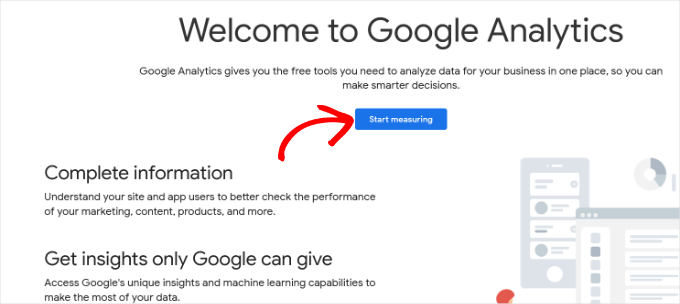
After that, you will be asked to provide an account name.
This name will be used internally, so you can use anything, like your business name.
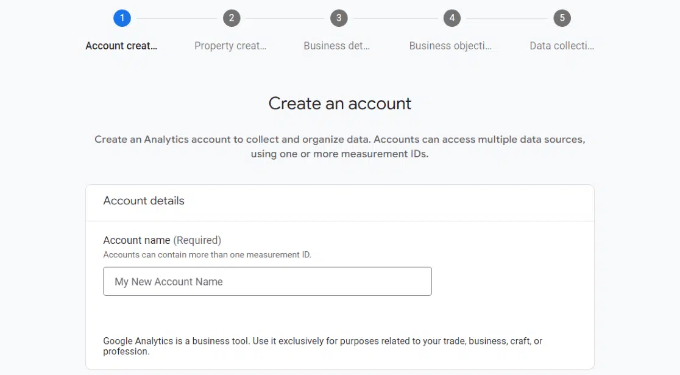
Google Analytics will also show multiple account data-sharing settings.
These settings give you control over sharing your Google Analytics data. You can keep the default settings and move on to the next step.

Step 3: Set Up a Google Analytics Property
On the next screen, you will need to create a Google Analytics property.
Google introduced a new version of Analytics called Google Analytics 4 or GA4. It’s the latest version that tracks your website and mobile apps in the same account. Plus, you get new features, metrics, and a different interface for your reports.
Go ahead and enter a property name and select your reporting time zone and currency. Then click the ‘Next’ button.
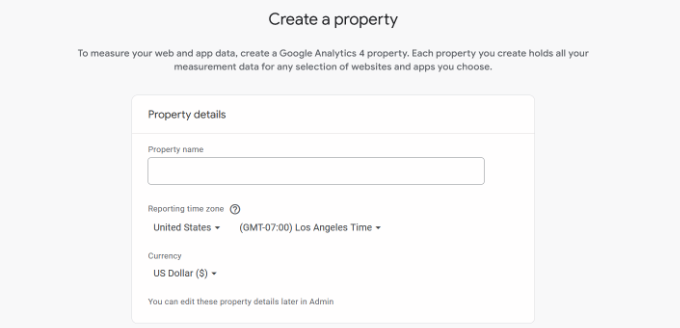
On the next screen, you’ll need to select an ‘Industry category’ from the dropdown menu for your website and choose a ‘Business size’ from the given options.
When you are done, just click the ‘Next’ button.
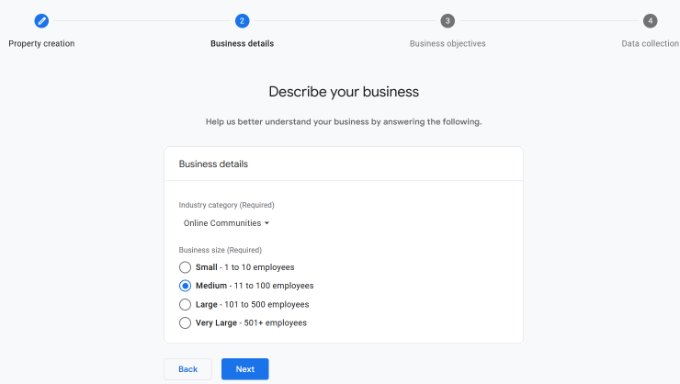
Next, you’ll need to choose business objectives and select how you intend to use Google Analytics with your business. This will help get personalized reports for your business.
For instance, there are options like generating leads, driving online sales, raising brand awareness, examining user behavior, and more.
You can select one or more options that meet your needs. We recommend selecting the ‘Get baseline reports’ option so that you get all the Google Analytics reports populated in your account.
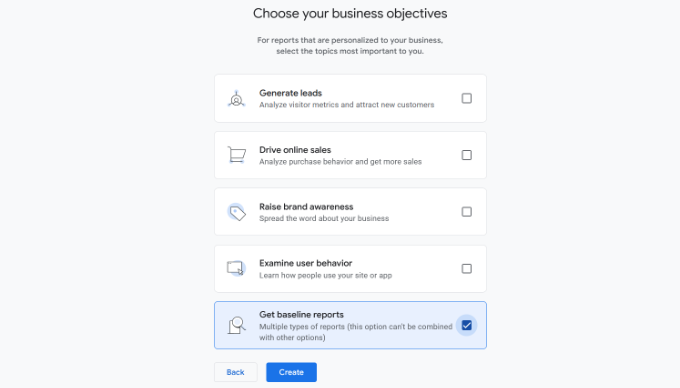
When you are done, simply click the ‘Create’ button.
Step 4: Connect Google Analytics with Your WordPress Site
Now you will be presented with your Google Analytics Webstream options.
Since we are setting up Google Analytics for a WordPress site, go ahead and select ‘Web’ as the platform.
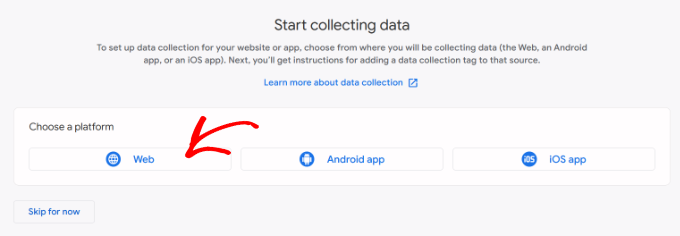
After that, you’ll need to enter your website URL and Stream name.
By default, Google Analytics will have an ‘Enhanced measurement’ option enabled. This allows you to track pageviews, scrolls, outbound clicks, file downloads, and more in Google Analytics.
📝 Note: If you plan to use the MonsterInsights plugin, then you should turn off the ‘Enhanced measurement’ option. Otherwise, the plugin will collect and display double the amount of data.
Next, you can click the ‘Create stream’ button.
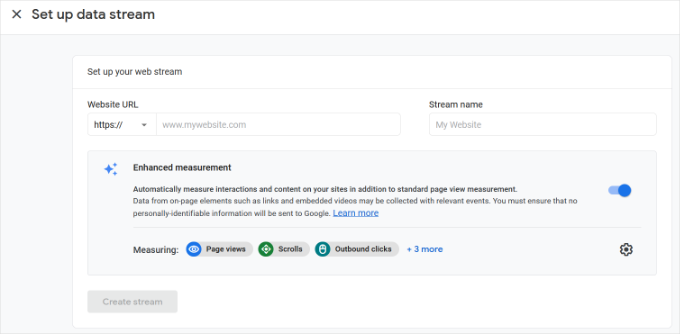
You can now see your Stream name, URL, ID, and Measurement ID.
It will also show different enhanced measurements that it will record.
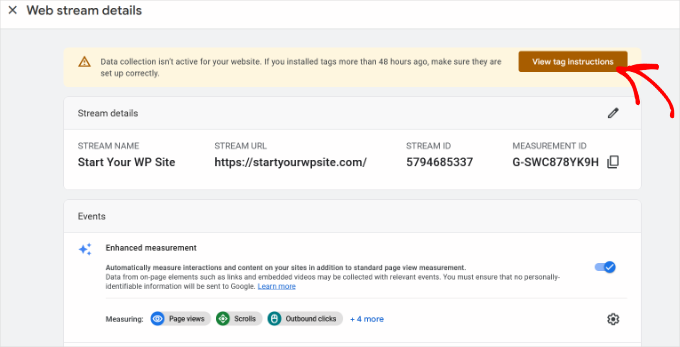
At the top, you will also see an alert bar that will show you how to add Google Analytics to your WordPress site.
Go ahead and click the ‘View tag instructions’ button. You should now see different ways to add the Google Analytics tracking code to your WordPress website.
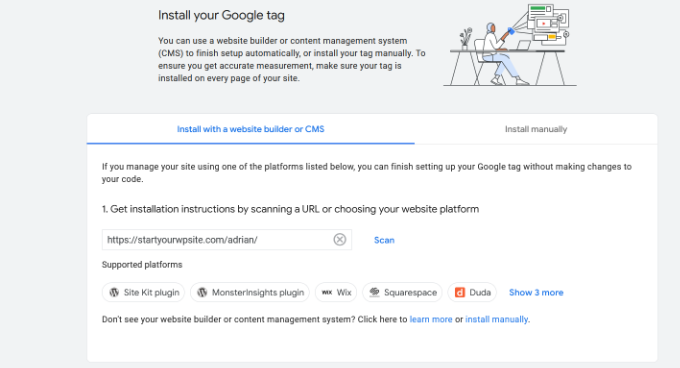
Next, you can switch to the ‘Install manually’ tab.
You’ll then see the Google Analytics tracking code.
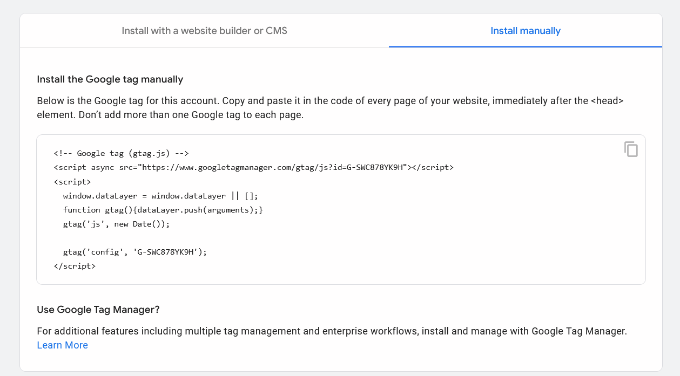
Go ahead and copy this tracking code because you will need to enter it in your WordPress site, depending on the method you use below. You can also simply leave this browser tab open and switch back to copy the code when needed.
We suggest leaving the ‘Analytics’ browser tab open. It’s because you may need to revisit it once you have installed the code on your WordPress site.
Now, let’s take a look at how to install Google Analytics in WordPress. Here is a quick overview of what you’ll learn in this article:
- How to Install Google Analytics in WordPress
- Method 1: Install Google Analytics in WordPress with MonsterInsights (Easy)
- Method 2: Install Google Analytics in WordPress with WPCode (Manual)
- Method 3: Install Google Analytics in WordPress Theme (Advanced)
- Bonus Tip: How to View Reports in Google Analytics
- FAQs About Installing Google Analytics in WordPress
- Video Tutorial: Install Google Analytics in WordPress
- Keep Learning: Using Analytics to Grow Your WordPress Site
How to Install Google Analytics in WordPress
There are a few different ways to set up Google Analytics in WordPress. We will show you three methods, where the first option is the easiest and the last is the hardest.
You can choose the one that best suits your needs.
💡 Pro Tip: You need to use only one of these methods on your website to avoid double-tracking of pageviews in your Google Analytics account.
Method 1: Install Google Analytics in WordPress with MonsterInsights
MonsterInsights is the most popular Google Analytics plugin for WordPress. Over 3 million websites use it, including the likes of Bloomberg, PlayStation, Zillow, WPBeginner, and more.
It is the easiest and, by far, the best way to add Google Analytics to WordPress (for all users, beginners, and experts alike). MonsterInsights is available as both a paid premium plugin and a free version.
At WPBeginner, we use MonsterInsights for various tracking tasks, such as form submissions, CTA button clicks, and referral link performance. Learn why it’s a great plugin in our complete MonsterInsights review.
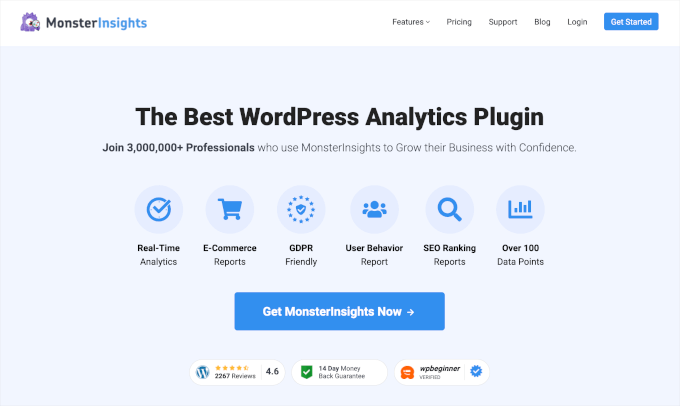
In this tutorial, we will be using the MonsterInsights free version.
You can use the MonsterInsights Pro version if you want more advanced features like eCommerce tracking, ad tracking, author tracking, and so on. The process of setting them up is the same.
Let’s get started.
The first thing you need to do is install and activate the MonsterInsights plugin. For more details, see our step-by-step guide on how to install a WordPress plugin.
Upon activation, the plugin will add a new menu item labeled ‘Insights’ to your WordPress admin menu, and you’ll see a welcome screen. Go ahead and click the ‘Launch the Wizard’ button.
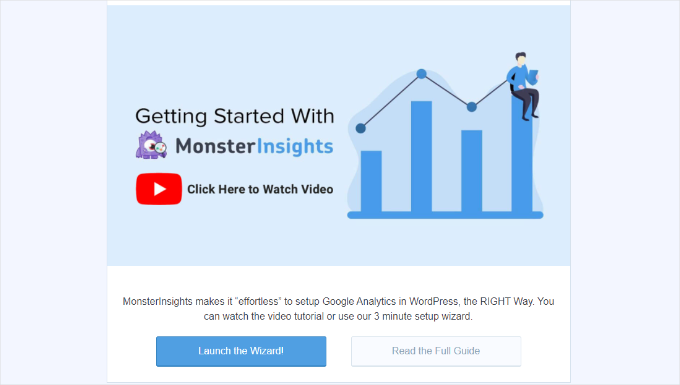
Clicking on it will open the MonsterInsights setup wizard.
First, you will be asked to choose a category for your website (a business website, blog, or online store). Select one and then click on the ‘Save and Continue’ button.
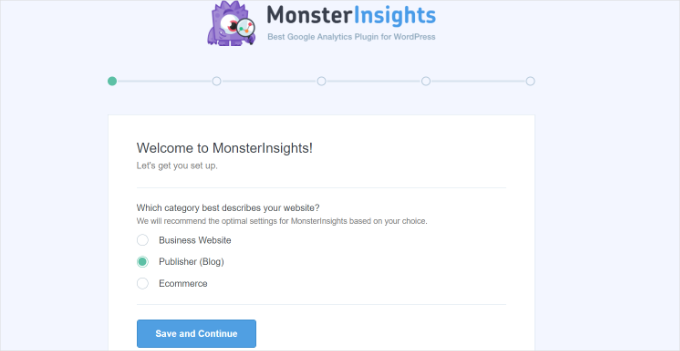
Next, you need to connect MonsterInsights with your WordPress website.
Simply click on the ‘Connect MonsterInsights’ button.
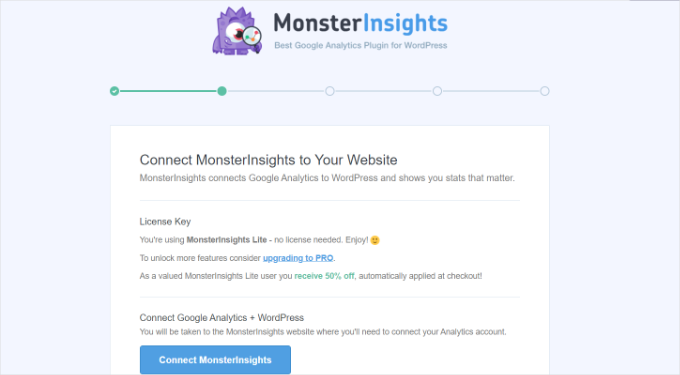
This will take you to Google accounts, where you will be asked to sign in or select a Google account if you are already signed in.
Go ahead and choose your Google account or enter your email to sign in.
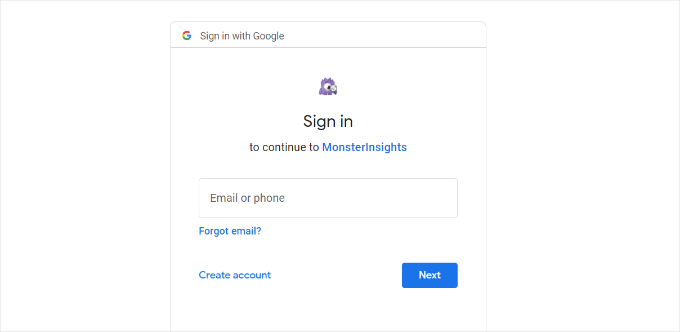
Next, you will be asked to allow MonsterInsights to access your Google Analytics account.
Click on the ‘Allow’ button to continue.
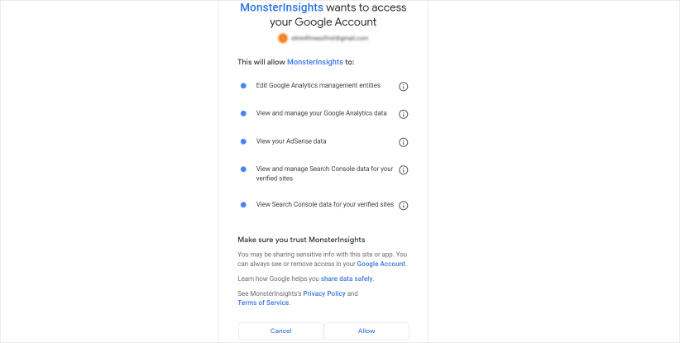
The next step to completing the connection is to select the profile you want to track.
You need to select your website here and then click on the ‘Complete Connection’ button to continue.
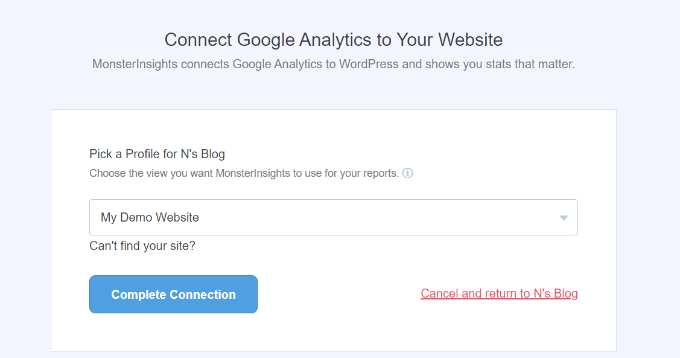
After that, simply click on the ‘Complete Connection’ button to continue. MonsterInsights will now install Google Analytics on your website.
Next, you will be asked to select the recommended settings for your website.
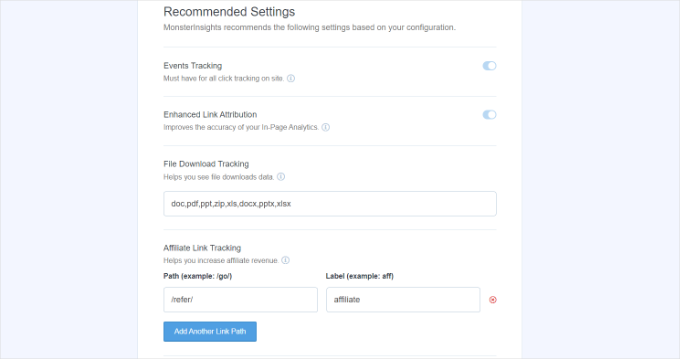
The default settings will work for most websites. If you use an affiliate link plugin, then you need to add the path you use to cloak affiliate links. This will allow you to track your affiliate links in Google Analytics.
MonsterInsights will also ask who can see the reports. You can choose different WordPress user roles.
Once you are done, just click on the ‘Save and Continue’ button to save your settings.
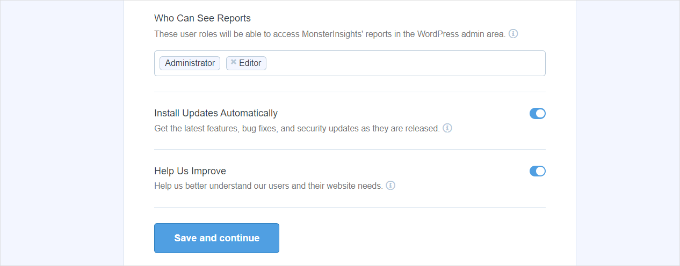
Next, MonsterInsights will show you a list of website tracking features you would like to enable.
You can scroll down and click on the ‘Continue’ button or the ‘Skip for Now’ option.
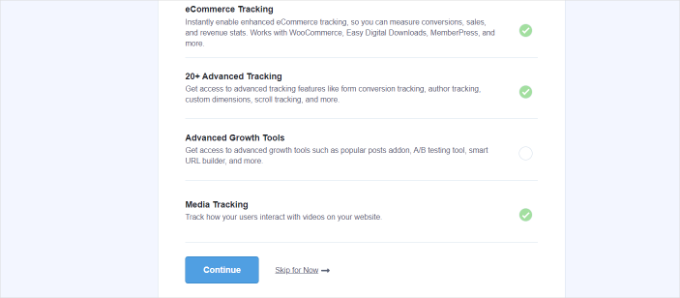
On the next screen, MonsterInsights will show that you’ve successfully set up Google Analytics tracking.
You can see that Google Analytics is connected, the tracking code is installed, and data is now being collected.
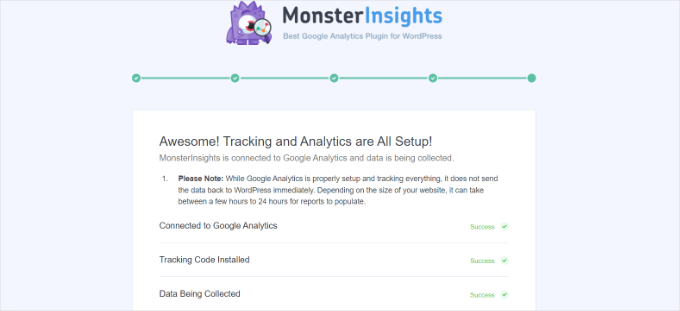
Next, you can scroll down and see a field to enter your license key.
Go ahead and click the ‘Complete Setup without Upgrading’ option for now.
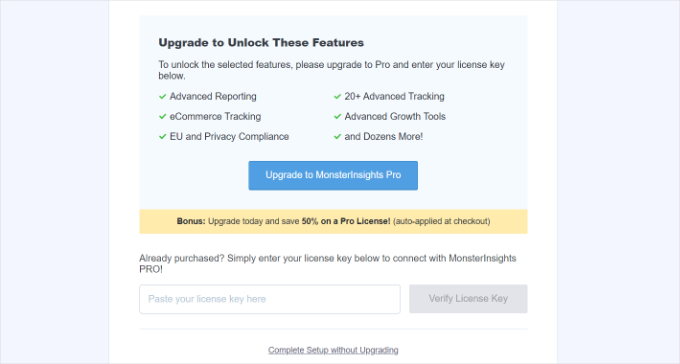
You’ve successfully added Google Analytics to your WordPress website.
Disable Enhanced Measurement in Google Analytics
Now, if you created a Data Stream in GA4 on your own instead of letting MonsterInsights create one, then you’ll need to switch off Enhanced Measurement.
That’s because MonsterInsights adds multiple custom-enhanced tracking features. Leaving the Enhanced Measurement option enabled will skew your data and show incorrect results.
First, you can head to the Google Analytics tab or window in your browser. From here, click on the ‘Admin’ settings option in the bottom left corner.
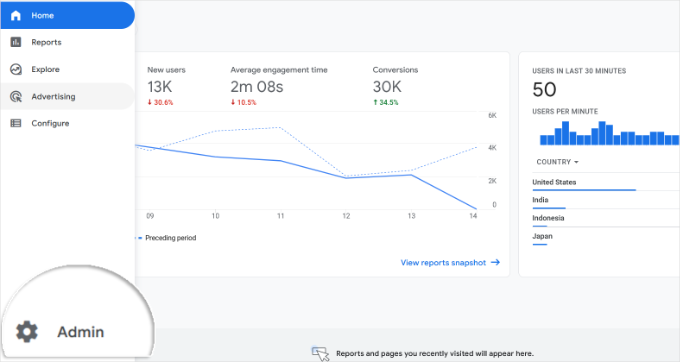
Once you are on the ‘Admin’ page, you’ll see different settings.
Simply click on the ‘Data Streams’ option.
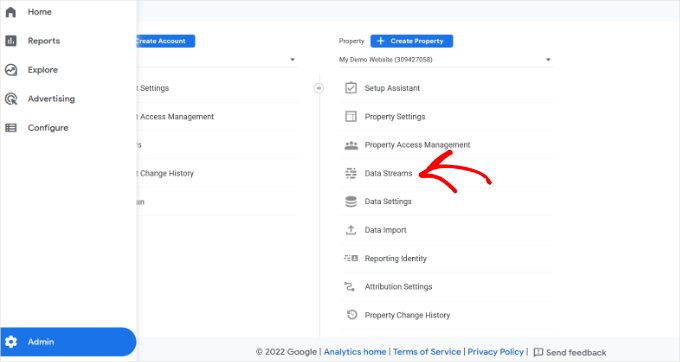
Next, you’ll see your Data Streams.
Simply select the data stream you connected with MonsterInsights.
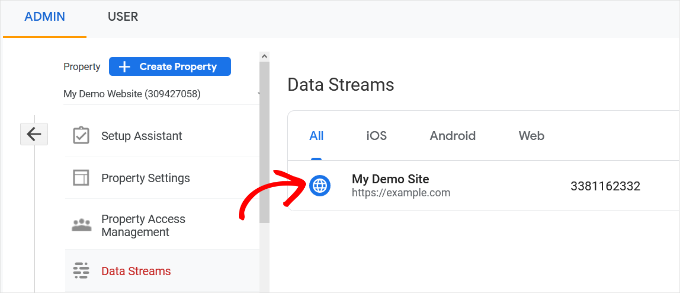
On the next screen, you will need to disable the ‘Enhanced measurement’ option.
To do that, simply click the toggle.
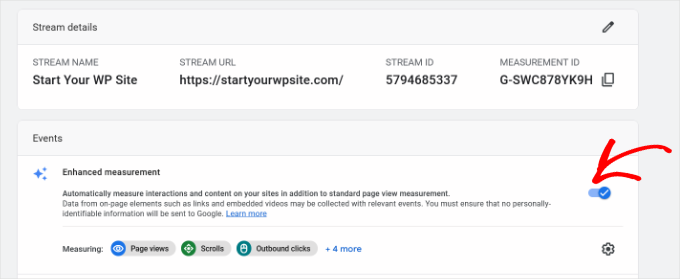
Next, a popup window will open, confirming that you’d like to turn off the enhanced measurement.
Go ahead and click the ‘Turn off’ button.
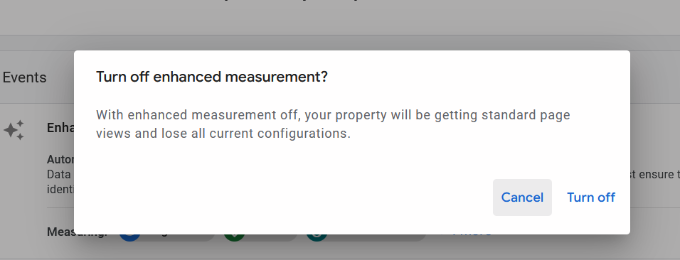
Change Data Retention Settings in Google Analytics
By default, Google Analytics will set the data retention setting to 2 months. However, you can change this so that you can use your data in custom reports beyond 2 months.
First, you need to head to Admin » Data Settings » Data Retention in Google Analytics.
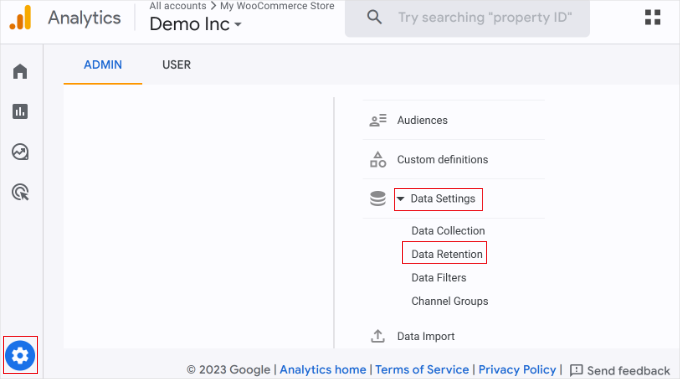
Next, you can click the ‘Event data retention’ dropdown menu.
From here, simply select the ’14 months’ option and click the ‘Save’ button.
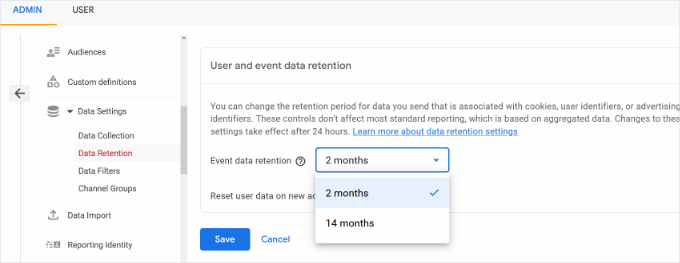
Remember, it will take Google Analytics some time before showing your stats.
💡 Pro Tip: Google Analytics lets you extend data retention to 14 months, but even if you choose the default 2-month option, privacy rules like GDPR still apply.
For that reason, you still need to get user consent before tracking, and it’s a good idea to mention how long you keep data in your privacy policy.
Not sure how to get started? Check out our guide on how to add a cookie popup in WordPress for GDPR/CCPA.
View Google Analytics Reports Inside the WordPress Dashboard
The best thing about MonsterInsights is that you can view your Google Analytics reports inside your WordPress dashboard.
Simply visit the Insights » Reports page to check out a quick overview of your analytics data.
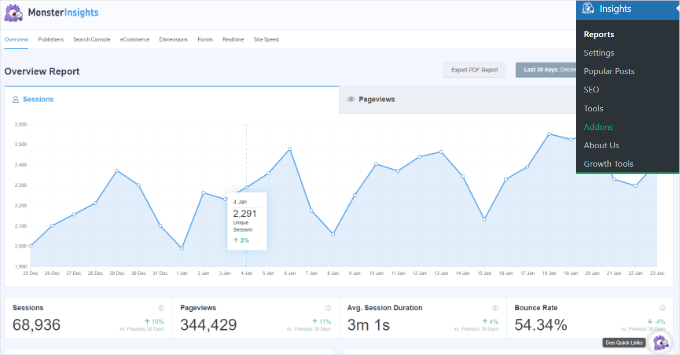
You can also add annotations directly to your MonsterInsights reports to record key changes you make to your website.
For example, you can add a note when you publish a new blog post, add a new landing page, and so on. This makes it easy to track how these events impact your traffic.
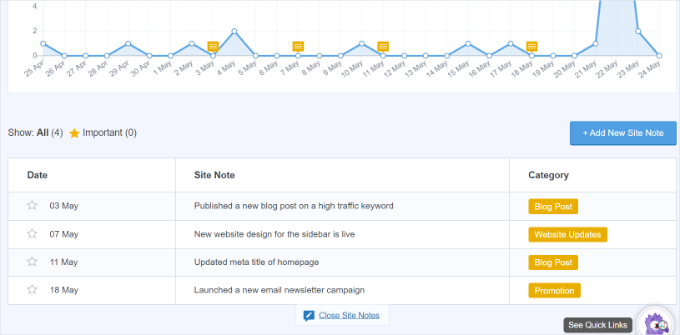
For more details, see this guide on how to get GA4 site annotations in WordPress.
You can even just ask MonsterInsights about the website stats you’re interested in. Thanks to the Conversations AI feature in MonsterInsights Pro.
For instance, if you have an eCommerce website, you can ask how much revenue you made from a product in a specific time period.
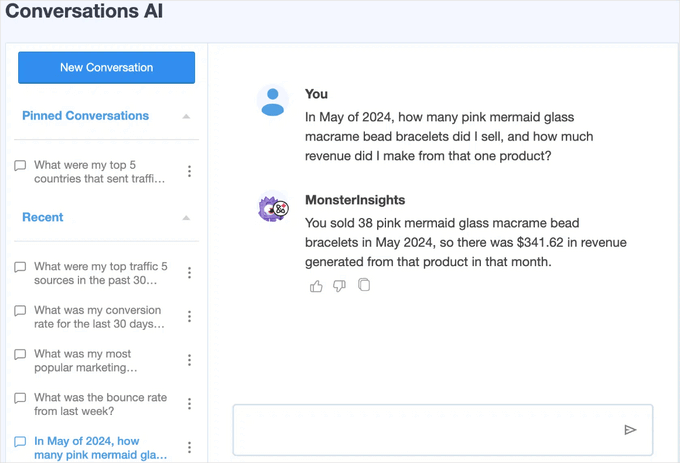
This is much easier than searching through your reports to find the data you need, especially if you’re just starting out with analytics.
In addition, MonsterInsights comes with a Popular Posts addon that allows you to show your top-performing content to boost your traffic and pageviews.
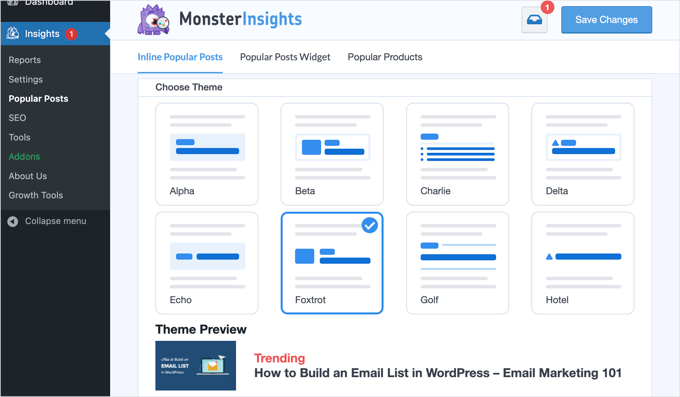
You can use it to automatically add inline popular posts links to boost engagement.
If you are running an online store, it can also automatically add your top-performing products at the end of each blog post to boost sales. (The popular products feature is available in the Pro version of MonsterInsights.)

If you run a WordPress blog, then the Page Insights addon (available in MonsterInsights Pro) will be super helpful.
Once installed, it will automatically add your blog stats in your ‘All Posts’ screen, the front end (while logged in), and the content editor screen.
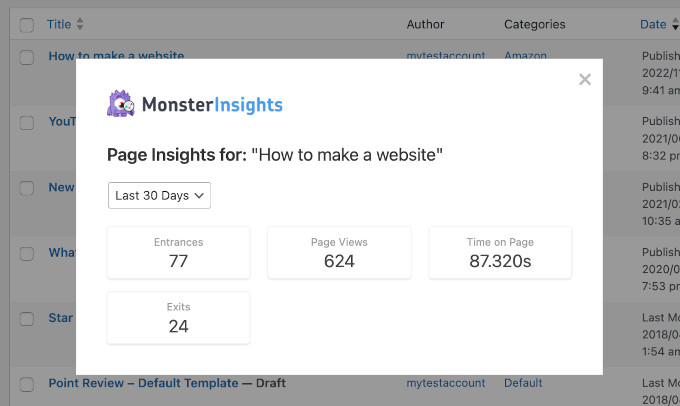
🌟 Insider Note: MonsterInsights was formerly known as Google Analytics for WordPress by Yoast. WPBeginner’s founder, Syed Balkhi, acquired the plugin in 2016 and rebranded it to MonsterInsights. Now, it is part of our family of premium WordPress plugins.
Method 2: Install Google Analytics in WordPress With WPCode
In this method, we’ll show you how to manually install Google Analytics in WordPress. We’ll use WPCode to add the GA4 tracking code to your site’s header.
Before we start, do note that this method is not as good as MonsterInsights because you will not be able to do advanced tracking configuration. Also, you will not be able to view Google Analytics data in your WordPress dashboard.
The WPCode plugin lets you safely add custom code snippets to your WordPress site without editing theme files.
Some of our business partners use WPCode to manage tracking scripts, custom features, and other advanced settings, and it’s been working exceptionally well. To learn more about the plugin, check out our full WPCode review.

First, copy the Google Analytics tracking code (Global site tag) that you created in Step 4 when setting up your Google Analytics account.
Here’s what it might look like in the interface:

Next, you need to install and activate the WPCode plugin. For more details, see our step-by-step guide on how to install a WordPress plugin.
📝 Note: You can use the free WPCode plugin to install the Google Analytics tracking code.
But upgrading to WPCode Pro unlocks more powerful features — like complete revision history to help you track changes and code scheduling to automatically enable or disable snippets at specific times.
Upon activation, you need to visit the Code Snippets » Header & Footer page. Here, you must paste the Google Analytics tracking code that you copied earlier into the ‘Header’ section.
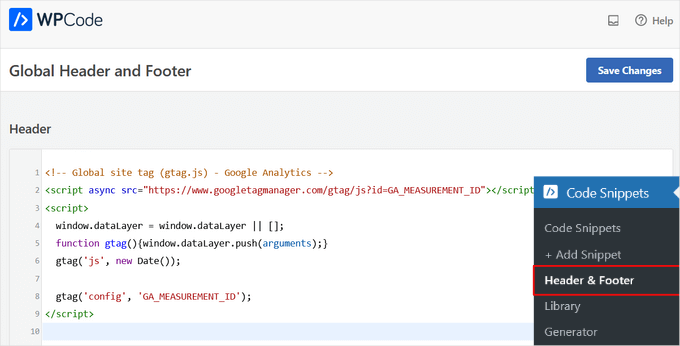
Don’t forget to click the ‘Save Changes’ button to store your settings.
That’s all, you have successfully installed Google Analytics on your site.
Method 3: Install Google Analytics in a WordPress Theme
⚠️ Warning: This method is only for advanced users. It involves editing your theme’s code directly, which can easily break your site if done incorrectly.
Another downside is that your tracking code will be lost whenever you update or switch themes, making this method unreliable in the long run.
If you’re not comfortable editing code, we strongly recommend using Method 1 (MonsterInsights) or Method 2 (WPCode) instead.
In this method, we’ll show you how to add tracking code manually without using a plugin. This gives you full control over where the script goes in your theme files.
That said, it’s best suited for advanced users who are comfortable working with code.
To do this, you will first need to copy the Google Analytics tracking code that you copied in Step 4 earlier. You can view it in the Web Stream Installation section under the ‘Install manually’ tab.

Now, there are two common ways to add this code to your WordPress theme files. You can choose either one of them (not both):
Add Code in header.php File
Simply edit the header.php file in your WordPress theme and paste the Google Analytics tracking code you copied earlier, placing it immediately before the closing </head> tag.
Don’t forget to save your changes and upload the file back to your server.
Add via Functions File
You can also add Google Analytics tracking code to the WordPress functions file. It will then automatically add the tracking code to every page on your WordPress site.
You will need to add this code to your theme’s functions.php file.
<?php
add_action('wp_head', 'wpb_add_googleanalytics');
function wpb_add_googleanalytics() { ?>
// Paste your Google Analytics tracking code from Step 4 here
<?php } ?>
Don’t forget to replace the ‘Paste your Google Analytics tracking code from Step 4 here’ section in the above snippet with your Google Analytics code.
Bonus Tip: How to View Reports in Google Analytics
Google Analytics is capable of showing you a treasure trove of data collected from your stats. You can view this data by visiting your Google Analytics dashboard.
Google Analytics 4 reports are a bit different from previous Universal Analytics reports. In the left column, you’ll see a dedicated Reports option. The reports are grouped together under 2 broad categories: Life Cycle and User.
One of the most noticeable differences you’ll find in GA4 reports is that bounce rate is calculated differently. It’s now the percentage of sessions that were not ‘engaged,’ which gives you a clearer picture of how visitors interact with your site.
Other than that, you’ll find a new reporting interface, new metrics like engagement time, no goals in GA4, and more.
Here’s a breakdown of the different reports in Google Analytics 4:
- Realtime: Shows active users on your site right now.
- Acquisition: Shows how users found your website (e.g., organic search, referrals, email).
- Engagement: Shows what users do on your site, including key events and conversions.
- Monetization: Tracks eCommerce data, such as purchases and revenue.
- Retention: Shows how well you retain visitors by comparing new vs. returning users.
- User Attributes: Breaks down your audience by country, city, gender, and interests.
- Tech: Shows which devices, browsers, and operating systems people use to view your site.
You will see these Google Analytics reports in the left column. Each section is divided into different tabs, and clicking on a tab will expand it to show more options.
Here’s what it might look like in the reporting dashboard.
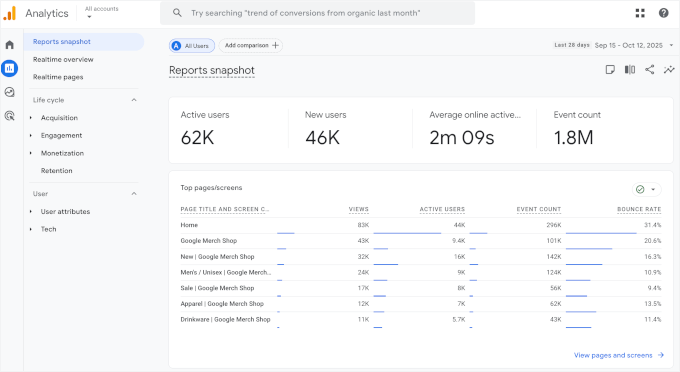
🧑💻 Pro Tip: We also highly recommend connecting Google Analytics with Google Search Console. This allows you to see how your site performs in search results. See our complete Google Search Console guide to learn how to use it to grow your website.
Finally, to improve your WordPress SEO rankings and get more traffic, we recommend using the AIOSEO plugin. It’s a complete toolkit that helps you optimize your site with sitemaps, schema markup, and everything else you need to rank higher.
There’s a free version of AIOSEO that you can use to get started.
FAQs About Installing Google Analytics in WordPress
Here are answers to some of the most common questions we get about setting up Google Analytics.
Is Google Analytics free to use?
Yes, Google Analytics is completely free. They offer a premium version for very large enterprise websites, but the free version is more than powerful enough for the vast majority of small business sites and blogs.
How long does it take for Google Analytics to start working?
After adding the tracking code to your site, Google Analytics may take a few hours to begin collecting and displaying data in your reports. We recommend checking back after 24 hours to see your first full day of statistics.
Do I need Google Analytics if my site has Jetpack stats?
Jetpack stats provide a simple overview of your traffic.
But Google Analytics is a much more powerful and comprehensive tool. It gives you far more detail about your audience, their behavior, and how they found your site, which is essential for making informed decisions to grow your website.
For details, see our comparison article on Google Analytics vs. Jetpack Stats.
Video Tutorial: Install Google Analytics in WordPress
Before you go, don’t miss our video tutorial on how to install Google Analytics in WordPress to see the process in action. ▶️
Keep Learning: Using Analytics to Grow Your WordPress Site
We hope this article helped you learn how to install Google Analytics in WordPress.
Next, you might want to see some more resources that will help you make the most out of Google Analytics reports:
- How to Track User Engagement in WordPress with GA
- How to Set Up WordPress Form Tracking in GA
- How to See Search Analytics in WordPress
- How to Track Outbound Links in WordPress
- How to Keep Personally Identifiable Information Out of GA
- How to Get a Custom Email Alert in Google Analytics
- How to Track WooCommerce Customers in Google Analytics
- Ultimate Guide to GA4 in WordPress for Beginners
If you liked this article, then please subscribe to our YouTube Channel for WordPress video tutorials. You can also find us on Twitter and Facebook.





William Hails
I don’t know what I did wrong but my setup is not complete… it is not connected to my gmail account but only to my website ?
WPBeginner Support
If you have created your account then you should be able to log in with the google account you signed up with. If you have multiple Gmail accounts you may want to change accounts to see if you set up analytics on a different account.
Admin
faisal
may time i tried to install google analystics i functions.php in wordpress.
its given errors
.Your PHP code changes were rolled back due to an error on line 67 of file wp-content/themes/Extra/functions.php. Please fix and try saving again.
syntax error, unexpected ‘<', expecting end of file.
guide me what i do now.whats its solutions.
WPBeginner Support
You would want to try removing line 1 from the code in our guide for that specific error.
Admin
Tikyda
Thanks a lot for sharing on how to install Google Analytics.
WPBeginner Support
Glad our guide was helpful
Admin
Marsha
I installed Google Analytics to my blog using Monster Insights via the tutorial above but I can only see analytics using the Monster Insights dashboard on WP, the analytics is not showing up on the Google Analytics website at all.
WPBeginner Support
You would want to make sure if you have multiple properties that you’re checking the correct one and you have given 48 hours for Google Analytics to populate the data.
Admin
Elena
I keep getting this message:
“The selected account doesn’t have any Google Analytics Web properties.
Please select another Google Account and make sure your Google Analytics property is set as “Web” not “Apps and web” or “Apps”.
You can find more details about setting up your Google Analytics property in this article.
Try picking a different app/profile to auth into”
I’ve linked my account to Web only, but I don’t know if it’s an issue with how I worded the property? Please help! Thank you!
WPBeginner Support
If you have multiple properties, ensure you are connecting to the correct one, you can also reach out to MonsterInsight’s support for assistance with that error if everything is set correctly.
Admin
Lourdes
Super Helpful!!!! thanks!!
WPBeginner Support
You’re welcome
Admin
Claire
Can you set up Google Analytics for multiple websites with the same Google account? And how?
WPBeginner Support
In your Google Analytics Admin section, there is the option to add a new account that would be your new site.
Admin
David Pasquaone
Thanks! Exactly what I needed. ✌
WPBeginner Support
You’re welcome, glad our guide was helpful
Admin
putri
Thank you for the post! Your content helps me a lot in setting Google Analytics up!
WPBeginner Support
You’re welcome, glad our guide was helpful
Admin
Charlotte van Noord
after following the instructions I got this error showing up:
syntax error, unexpected ‘<', expecting end of file
WPBeginner Support
It would depend on how you are attempting to add the code, you may want to try some of the other recommended methods in the article for the moment.
Admin
Kiran
Very helpful for the beginner
WPBeginner Support
Glad you found our guide helpful
Admin
mahmoud
Thanks.
Great information
WPBeginner Support
You’re welcome, glad our guide was helpful
Admin
Thomas
Thank you for making this well thoughtout content. For FREE!
WPBeginner Support
You’re welcome, glad you’ve found our content helpful
Admin
shine htet linn
Dear Team,
I tried to connect Google analytics code to the wordpress using insert Header and Footer plugin. But when i verify it said “verification unsuccessful”. Please help me to solve it.
WPBeginner Support
You would want to start by clearing the caching on your site for the most common solution to this issue.
Admin
Srai
Excellent instructions. Thanks a bunch!
WPBeginner Support
You’re welcome, glad our guide was helpful
Admin
Stephanie
Amazing! I love how you walked through each step, was so much easier to understand, all three methods when watching you calming and in real time go through it as a newbie.
Bookmarking and Subscribing
WPBeginner Support
Glad our guide was helpful
Admin
David ayeni
thanks alot, this was really helpful, fixed it in minutes, How to i add adsense to my website after that, is there any article on that
WPBeginner Support
For adding Adsense you would want to take a look at our article below:
https://www.wpbeginner.com/beginners-guide/how-to-add-google-adsense-to-your-wordpress-site/
Admin
Chisom
Hello, Thanks for this helpful article, but i have a question,
If i use the Monster insight or the “Insert header and footer plugin”, if i create a new page after setting the analytics up, will it be automatically added to the new page or i will have to set it up again.
WPBeginner Support
Using either of those methods would automatically add the code to your new posts and pages
Admin
Ian Warner
Thanks for this helpful information. I want to install Google Analytics without Google Tag Manager. Where do I find the code for this please?
WPBeginner Support
You would not add Google Tag Manager if you do not want to use it on your site.
Admin
Dileepa K
Thanks for this detail explanation. Very helpful
WPBeginner Support
You’re welcome
Admin
Gabbi
OMG so helpful and easy! Follow all the steps now I am set up! Thanks a bunch
WPBeginner Support
You’re welcome
Admin
Brian
Very helpful. The steps to take were clear and understood.
WPBeginner Support
Glad you found our article helpful
Admin
Helen C
Thanks, I dont know alot about any of this but I installed google analytics with no problem by following your tutorial.
Now on to something else!
WPBeginner Support
Glad our guide was able to help
Admin
Eli
Super helpful; thanks brother.
WPBeginner Support
You’re welcome
Admin
Johnny Come Lately
Thank you! Very useful video. I used the Headers and Footers Plugin as I prefer to have google analytics app on my phone and I can view all websites from that.
taekookyizhan
this article was super helpful and contained everything I wanted to know. thank you
WPBeginner Support
You’re welcome
Admin
Paul
Can’t wait to learn more.
WPBeginner Support
We hope our guides can help
Admin
Heather
Thank you! This was super easy to follow and I was able to setup Google Analytics using Monster Insights very quickly following this guide.
WPBeginner Support
You’re welcome, glad we could help simplify the process
Admin
Amin Al Salim
It’s quite very good and useful
WPBeginner Support
Thank you, glad you found our guide helpful
Admin
Avi
Hey! Amazing tutorial.
But while going with the 3rd method I faced an error which says :
Your PHP code changes were rolled back due to an error on line 1006 of file wp-content/themes/oceanwp/functions.php. Please fix and try saving again.
syntax error, unexpected ‘<', expecting end of file
Please help.
WPBeginner Support
Your functions.php likely did not close its PHP, you should be able to add the code without the first line
Admin
Rich
Yep, that worked for me – removed ‘<?php' and the error dispeared.
Thanks..
dell
Hi. My plan is free. It doesn’t support plugin installation. In that case, what can I do for using google analytics?
WPBeginner Support
For WordPress.com sites, you would need to check with the support documentation for what they allow at the moment.
Admin
Lisanne
Hello,
I did instal Google Analytics correctly and it works perfectly!
But it is tracking my own IP as well.
Is there an solution to this problem?
I couldn’t found it anywhere.
WPBeginner Support
This is one of the reasons why we recommend MonsterInsights, it should filter out your own visits without needing to set up a filter in Google Analytics.
Admin
Enni
I follow the steps exactly from the video tutorial, but I can’t update my file of theme editor, it says this:
Your PHP code changes were rolled back due to an error on line 83 of file wp-content/themes/neve/functions.php. Please fix and try saving again.
syntax error, unexpected ‘<', expecting end of file
WPBeginner Support
We would recommend taking a look at our guide on copying snippets from the web below for the most common reasons for an issue like that:
https://www.wpbeginner.com/beginners-guide/beginners-guide-to-pasting-snippets-from-the-web-into-wordpress/
Admin
Janet
Thank you for all of this, G Analytics is something I struggle with implementing as my brain shuts down at the thought, but you’ve made it more clear to me!
I’m using Insert Headers and Footers to paste the code, but I already have code on there for other stuff – can I paste code directly below?
WPBeginner Support
Yes, you would add the new code below your current code
Admin
Peggy
Thank you. I am just launching my website and you have been such a great resource. This quickly explained how to set up Google analytics in my website and I love that I don’t have to put code on each page as I was very confused on the google analytics page.
WPBeginner Support
Glad our guide was able to simplify the process for you
Admin
mayank jain
thannks a lot man ..really helped alot
WPBeginner Support
Glad our article was helpful
Admin
Efren
Really cannot find a good site where to explain how to add the Google tracking code to a wordpress site without plugin. Why plugin is needed anyway? IS there any other website apart from this wordpress where i can add the hmtl code i want without having to purchase, add plugin, update my account or anything like that? Man, they make it complicated
WPBeginner Support
It sounds like you are on WordPress.com which would be the main factor for that issue, you may want to take a look at our comparison here:
https://www.wpbeginner.com/beginners-guide/self-hosted-wordpress-org-vs-free-wordpress-com-infograph/
WordPress.com requires one of their paid plans currently to connect Google Analytics
Admin
andreia
just to say thank you
WPBeginner Support
You’re welcome, glad you liked our guide
Admin
Jaymin Thakkar
Hello,
I’m using #3 to add GA in Wordpress Theme. I just wanted to know if add code in header.php file then do I also have to add via functions.php? Will only update in header.php work?
WPBeginner Support
You would use one of the methods, you would not want to use both and it is personal preference on which method you use
Admin
Jaymin Thakkar
Thank You so much for the information!
WPBeginner Support
You’re welcome
Elisabeth
Thank you so much for the information! You mention it takes some time for Google Analytics to connect to the website. How long is that process generally? My Siteground dashboard shows sessions and pageviews, but GA still shows zero.
Thanks for your help!
WPBeginner Support
normally 24-48 hours but times can vary
Admin
Sandra
Will this plugin report the hits back to my main analytics (web) account? Because I’m unable to paste the analytics code on my web pages.
Will like to hear your response, Thanks.
WPBeginner Support
As long as it is connected it will send the information back to your Google Analytics account.
Admin
Vanessa Williams
Thanks for sharing this topic. It’s help a lot.
WPBeginner Support
You’re welcome, glad you like our guide
Admin
Michael
Thanks for your excellent guides.
WPBeginner Support
You’re welcome, glad you like our guides
Admin
Kelly
Thank you for the information! I have Google Analytics, but didn’t know how to read it. You cleared that up here. Thanks
WPBeginner Support
You’re welcome, glad our guide was helpful
Admin
Cheri Moe
Thank you for continually posting articles and videos to help us walk through the process and set up great sites. I’ve been wanting to learn more about GA and this article and video were the perfect starting point for me!
WPBeginner Support
You’re welcome, glad our guides are able to help you
Admin
Sandra
I use Google Analytics all the time, but have not understood how to use the info. Great article.
WPBeginner Support
Thank you, we hope our recommended additional resources at the end help you understand how to use the information
Admin
Expy
Already installed google analytics on my website 8years ago now am thinking of changing the entire website thus I will need to reinstall it again. With this article I won’t have issue
WPBeginner Support
Glad our guide could be helpful to you
Admin
vanessa
This is very helpful info i love the video addition as well. Thanks for all the great help and work your team does.
WPBeginner Support
Thank you for your kind words and glad our guide could be helpful
Admin
David S
I am trying to install Google Analytics. By accident I selected Web & mobile instead of just Web for the property. How can I fix thiss?
WPBeginner Support
If you do not have any data on the page then you should have the option to delete it and create a new analytics page for the site
Admin
samptest
My company is using a wordpress theme and building our website. If I wanted to integrate the google analytics, Google tag manager account, Facebook pixels to my website. Can I still use the MonsterInsights plugin?
WPBeginner Support
Yes, you can still use MonsterInsights for a site wanting to add all of that
Admin